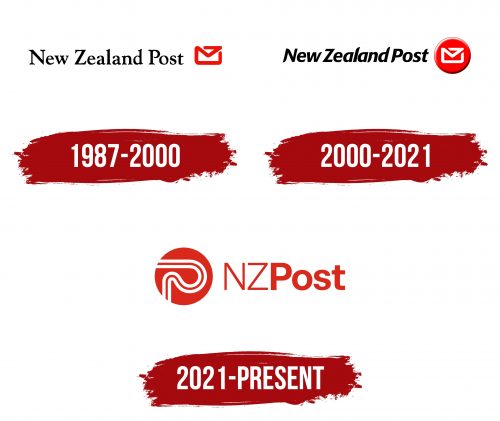The NZ Post logo exudes powerful energy, reflected in its bright color and dynamic shapes. This visual activity emphasizes the postal service’s modernity, which aims to break all records for delivery speed. Such an emblem is a perfect fit for an institution that connects the residents of a large country.
NZ Post: Brand overview
New Zealand Post (NZ Post) first existed during the colonial era. Not long after the Treaty of Waitangi was signed, the nation’s first mail service was established in 1840.
The first Mail Act, enacted in 1858, set the stage for developing a centralized mail system in New Zealand. Under this act, postage stamps were issued, and consistent postal service tariffs were set.
Since its official founding in the 1880s, the New Zealand Post Office has been responsible for the nation’s postal services. This organization was also responsible for savings banks, telegraph services, and postal delivery.
The enterprise was vital to the lives of New Zealanders for the majority of the 20th century. Post offices served as the hubs of local communities, particularly in tiny towns and rural areas. In addition to offering postal services, they also functioned as banks, phone booths, and weather stations.
The organization started using automated mail sorting systems in 1981, greatly improving mail processing efficiency.
But by the middle of the 1980s, it was evident that a multipurpose organization like this was becoming ineffective in a shifting economic environment. The enterprise underwent a reorganization decision made by the government in 1986.
On April 1, 1987, the organization split historically into three distinct entities: Telecom New Zealand Limited, which handled telecommunications; Postbank, which assumed control of banking activities; and New Zealand Post Limited (NZ Post), which handled postal services.
Initially, the new enterprise was a state-owned company to provide effective postal services in a market-oriented economy. The business had to upgrade and streamline its processes right away.
The postal code system was implemented in 1989, significantly enhancing mail sorting and delivery.
The 1990s brought quite several notable operational developments. The business started to offer more services than postal delivery. 1998, it entered the express delivery industry when it purchased Couriers Please, a courier firm.
The organization started digitizing its services in 1999 when it opened its first website.
The 2000s provided both new opportunities and challenges. The corporation needed to create new revenue streams because traditional mail volumes started to fall with the rise of electronic communication.
Kiwibank was established in 2002 as a new retail bank that offered banking services through the post office network.
The YouPost service, an online digital mailbox that lets users receive and pay invoices, was introduced in 2005.
The firm started a massive infrastructure modernization program in 2010 by investing in new mail sorting and delivery systems.
2013 saw several important modifications to the mail delivery system. The enterprise responded to the drop in traditional mail volumes by announcing a move to three-day regular mail delivery in urban areas.
With the introduction of the YouShop service in 2015, New Zealanders could purchase from overseas online retailers and have their purchases delivered by the postal service.
In 2018, the firm’s services became even more digital. The business unveiled a new smartphone app that lets users schedule and follow deliveries.
In 2019, the organization continued its policy of adjusting to the market’s shifting demands. The business made large financial investments to update its sorting system. In Auckland, a new sorting facility with cutting-edge automated technology opened. This center allowed the company to handle letters and packages faster, which was crucial considering the expanding e-commerce market.
The same year, the enterprise introduced a new platform for small and medium-sized enterprises, expanding its e-commerce offerings. This software is connected with well-known online trade platforms, giving business owners more effective capabilities for handling shipments and returns.
The company’s parcel delivery volume increased significantly in 2020, necessitating the expansion of its truck fleet. The business invested in new electric vans as part of its ongoing effort to lessen its carbon footprint. At the end of the year, more than thirty percent of the urban delivery fleet was made up of electric cars.
The firm used drones in a trial operation in 2021 to transport packages to remote, difficult-to-reach locations. The government of New Zealand supported the project, which was carried out in collaboration with regional technology companies. Despite being experimental, the project showed the organization’s dedication to service delivery innovation.
The enterprise’s management structure underwent major changes in 2022. As part of its organizational restructuring, the business established a distinct division to develop new services and digital technologies. This choice was made to quicken the company’s digital transition and create new goods that cater to consumers’ evolving wants.
In 2023, the organization increased its market share abroad by forming strategic alliances with postal services in several Asia-Pacific nations. These collaborations aimed to enhance digital technology exchange skills and cross-border logistics.
Meaning and History
What is New Zealand Post?
It is New Zealand’s national postal service. A network of post offices provides a wide range of postal and logistics services, including domestic and international mail delivery, parcel delivery, courier services, and retail services. It also offers financial services such as bill payment and banking through a partnership with Kiwibank, which operates in many post offices. The organization aims to connect people and businesses by providing reliable and affordable postal and logistics solutions throughout New Zealand.
1987 – 2000
The old logo appeared during the early days of NZ Post, using the service’s original name: New Zealand Post. It is complemented by a small pictogram of a white envelope outlined by a red stripe. This is a visual representation of the correspondence that postal workers deliver to millions of addresses every day. The curved line symbolizes the complex logistics involved, as parcels and letters travel long before reaching recipients. At the same time, the bright red color represents speed, one of the key elements of quality delivery.
The envelope outline is not closed; the stripe has a clear beginning and end. This shape conveys the postal service’s accessibility and openness. It also evokes the image of a long route connecting the starting and ending points. In this sense, the red line reflects the idea of connection, as NZ Post links people living in different parts of the country.
The black text draws attention with its long serifs, diagonal cuts, and contrasting stroke thickness. This elegant font resembles the typical fonts of print publications, reflecting one of the institution’s main tasks—delivering paper newspapers and magazines, which were in high demand before the rise of digital technologies.
The designers used Times New Roman or a similar font, making subtle modifications. The upper serifs of the letters “N,” “l,” “d,” and “P” have small notches that enhance the visual interest of the text. The varying line thickness and smooth curves add a sense of dynamism to the emblem, highlighting the high speed of postal deliveries. Another unique detail is the incomplete curve of the letter “P.” It creates a sense of openness, just like the unclosed outline of the envelope.
2000 – 2021
The postal service entered the third millennium with a new visual identity, reflecting the spirit of a progressive era. The structure of the logo remains unchanged: it still features the brand name and a stylized envelope. However, both the text and the image are now perceived differently due to several nuances that highlight the rapid advancement of technology.
- First, the phrase “New Zealand Post” is rendered in bold italics, unlike the formal newspaper font previously used. The noticeable slant gives the text a sense of motion, evoking the image of a fast-moving postal van. Another reason for this visual dynamism is the diagonal cuts at the ends of the letters, which are also rounded. This symbolizes modern solutions that accelerate the process of delivering letters and parcels.
- Second, the stylized envelope now sits on a round red base. This base resembles a large button due to a gradient that creates a 3D effect. The circle appears convex, with its top edge outlined by a soft white line and the bottom highlighted by a black shadow. The three-dimensional design is associated with progress and the implementation of innovative technologies that have significantly streamlined NZ Post’s operations. The button, in turn, symbolizes the universality and accessibility of services—something that is always within reach.
For greater contrast, the outline of the envelope has been recolored in white, as it now sits on a red background. The lines are no longer as soft and flowing as before; their curves now appear sharper, giving the emblem a sense of speed. The ends are diagonally cut and rounded, just like the letters in “New Zealand Post.” This small detail visually connects the text and the pictogram, making the logo feel unified.
The brand name stands out thanks to its rich black color, which conveys an aura of professionalism and seriousness. The large red button draws attention with its bold brightness, practically demanding that customers use the service. Meanwhile, the white line echoing the envelope’s shape adds a sense of calm, simplicity, and confidence, balancing the emotional intensity of the other elements in the logo.
2021 – today
This emblem appeared in the postal service in 2021 when it decided to consolidate several brands for customer convenience. The new visual identity was intended to unify the various trademarks so they would be perceived as a cohesive whole.
The altered logo reflects the evolution of NZ Post and demonstrates its forward-looking ambitions, as almost nothing remains of the previous design except for the red circle. However, this element no longer resembles a button—it now has a simple two-dimensional appearance, typical of the currently popular minimalism. The modern style emphasizes the accessibility and clarity of the service, as the institution is actively advancing, improving package sorting technologies, modernizing processing centers, and utilizing the latest transport for cargo handling.
Inside the red circle, the traditional envelope is no longer present. NZ Post’s services have long expanded beyond mail delivery: the state enterprise owns its bank, delivers KFC orders, and fully controls ECN Group. Thus, the brand needed a universal symbol that does not point to any specific activity area.
This became a stylized letter, “P,” formed by white grooves inside the red circle. It gives the impression that the designers simply untangled the outline of the envelope and laid it out in the form of two curving lines to add the needed fluidity to the logo. Between the white stripes is red space, which makes the “P” more noticeable and expressive. Thanks to this three-layer structure, the letter resembles a road—a symbol of transportation and logistics.
The road is meant to convey the idea of a connection between different places, but in this case, it looks like a road to nowhere because the ends of the white lines extend beyond the circle. The endless path indicates that there are no boundaries for the postal operator. It is a visual embodiment of development and progress, leading to an unknown future.
To the right of the graphic symbol is the inscription “NZ Post.” The short name was chosen for its conciseness and simplicity, as the brand identity is minimalist. The designers made the inscription the same red as the circle to prevent it from appearing dull. The maximum concentration of red is associated with activity, energy, and constant movement. The font enhances the logo’s dynamic, as the two parts of the inscription differ in thickness: “NZ” is in a thin grotesque, and “Post” is bold. This contrast is the only element that distinguishes the two words, as there is no space between them.








